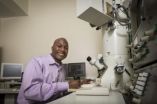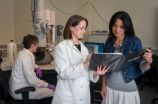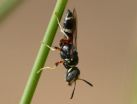(Press-News.org) Significant advances have been made in chemotherapy over the past decade, but targeting drugs to cancer cells while avoiding healthy tissues continues to be a major challenge.
Nanotechnology has unlocked new pathways for targeted drug delivery, including the use of nanocarriers, or capsules, that can transport cargoes of small-molecule therapeutics to specific locations in the body.
The catch? These carriers are tiny, and it matters just how tiny they are. Change the size from 10 nanometers to 100 nanometers, and the drugs can end up in the wrong cells or organs and thereby damage healthy tissues.
A common assumption is that once a nanocarrier is created, it maintains its size and shape on the shelf as well as in the body.
However, recent work by a group of researchers led by Thomas H. Epps, III, and Millicent Sullivan in the Department of Chemical and Biomolecular Engineering at the University of Delaware has shown that routine procedures in handling and processing nanocarrier solutions can have a significant influence on the size and shape of these miniscule structures.
Their findings are reported in a paper, "Size Evolution of Highly Amphiphilic Macromolecular Solution Assemblies Via a Distinct Bimodal Pathway," published in Nature Communications on April 7.
Sullivan explains that chemotherapeutic agents are designed to affect processes related to cell division. Therefore, they not only kill cancer cells but also are toxic to other rapidly proliferating cells such as those in hair follicles and bone marrow. Side effects can range from hair loss to compromised immune systems.
"Our goal is to deliver drugs more selectively and specifically to cancer cells," Sullivan says. "We want to sequester the drug so that we can control when and where it has an impact."
Although there are a number of routes to creating drug-carrying nanocapsules, there is growing interest in the use of polymers for this application.
"Molecular self-assembly of polymers offers the ability to create uniform, tailorable structures of predetermined size and shape," Epps says. "The problem lies in assuming that once they're produced, they don't change."
It turns out that they do change, and very small changes can have a very large impact.
"At 75 nanometers, a nanocarrier may deliver its cargo directly to a tumor," Epps says. "But with vigorous shaking, it can grow to 150 nanometers and may accumulate in the liver or the spleen. So simple agitation can completely alter the distribution profile of the nanocarrier-drug complex in the body."
The work has significant implications for the production, storage, and use of nano-based drug delivery systems.
About the research
The researchers used a variety of experimental techniques — including cryogenic transmission electron microscopy (cryo-TEM), small angle X-ray scattering (SAXS), small angle neutron scattering (SANS), and dynamic light scattering (DLS) — to probe the effects of common preparation conditions on the long-term stability of the self-assembled structures.
The work was carried out in collaboration with the University's Center for Neutron Science and the National Institute of Standards and Technology Center for Neutron Research.
The paper was co-authored by Elizabeth Kelley, Ryan Murphy, Jonathan Seppala, Thomas Smart, and Sarah Hann.
Thomas H. Epps, III, is the Thomas and Kipp Gutshall Chair of Chemical and Biomolecular Engineering, and Millicent Sullivan is an associate professor in the Department of Chemical and Biomolecular Engineering.
INFORMATION:
Financial support for the research was provided from an Institutional Development Award (IDeA) from the National Institutes of Health, National Institute of General Medical Sciences (NIH grant P20GM103541).
Nano shake-up
University of Delaware researchers demonstrate that processing can affect size of nanocarriers for targeted drug delivery
2014-04-14
ELSE PRESS RELEASES FROM THIS DATE:
Study says we're over the hill at 24
2014-04-14
It's a hard pill to swallow, but if you're over 24 years of age you've already reached your peak in terms of your cognitive motor performance, according to a new Simon Fraser University study.
SFU's Joe Thompson, a psychology doctoral student, associate professor Mark Blair, Thompson's thesis supervisor, and Andrew Henrey, a statistics and actuarial science doctoral student, deliver the news in a just-published PLOS ONE Journal paper.
In one of the first social science experiments to rest on big data, the trio investigates when we start to experience an age-related ...
Lashing out at your spouse? Check your blood sugar
2014-04-14
COLUMBUS, Ohio – Lower levels of blood sugar may make married people angrier at their spouses and even more likely to lash out aggressively, new research reveals.
In a 21-day study, researchers found that levels of blood glucose in married people, measured each night, predicted how angry they would be with their spouse that evening.
At the end of the 21 days, people who had generally lower levels of glucose were willing to blast their spouses with unpleasant noises at a higher volume and for a longer time than those who had higher glucose levels.
The study shows how ...
Ferns borrowed genes to flourish in low light
2014-04-14
DURHAM, N.C. -- During the age of the dinosaurs, the arrival of flowering plants as competitors could have spelled doom for the ancient fern lineage. Instead, ferns diversified and flourished under the new canopy -- using a mysterious gene that helped them adapt to low-light environments.
A team led by Duke University scientists has pinpointed the curious origins of this gene and determined that it was transferred to ferns from a group of unassuming moss-like plants called hornworts. The findings were announced today, April 14, in the Proceedings of the National Academy ...
Plugging an ozone hole
2014-04-14
CAMBRIDGE, Mass-- Since the discovery of the Antarctic ozone hole, scientists, policymakers, and the public have wondered whether we might someday see a similarly extreme depletion of ozone over the Arctic.
But a new MIT study finds some cause for optimism: Ozone levels in the Arctic haven't yet sunk to the extreme lows seen in Antarctica, in part because international efforts to limit ozone-depleting chemicals have been successful.
"While there is certainly some depletion of Arctic ozone, the extremes of Antarctica so far are very different from what we find in the ...
Fire and drought may push Amazonian forests beyond tipping point
2014-04-14
Falmouth, Mass. – Future simulations of climate in the Amazon suggest a longer dry season leading to more drought and fires. Woods Hole Research Center scientists Michael Coe, Paulo Brando, Marcia Macedo and colleagues have published a new study on the impacts of fire and drought on Amazon tree mortality. Their paper entitled “Abrupt increases in Amazonian tree mortality due to drought-fire interactions,” published in the Proceedings of the National Academy of Sciences, found that prolonged droughts caused more intense and widespread wildfires, which consumed more forests ...
Faithful allies since the Cretaceous
2014-04-14
Like humans, many animals depend on beneficial microbes for survival. Although such symbioses can persist for millions of years, the factors maintaining their long-term stability remain, in most cases, unknown. Scientists from the Max Planck Institute for Chemical Ecology and the University of Regensburg, in collaboration with researchers in the USA, now discovered that certain wasps tightly control mother-to-offspring transmission of their bacterial symbionts. This stabilizes the symbiotic alliance and contributed to its persistence over the past 68-110 million years. ...
'Problem wells' source of greenhouse gas at unexpected stage of natural gas production
2014-04-14
WEST LAFAYETTE, Ind. - High levels of the greenhouse gas methane were found above shale gas wells at a production point not thought to be an important emissions source, according to a study jointly led by Purdue and Cornell universities. The findings could have implications for the evaluation of the environmental impacts from natural gas production.
The study, which is one of only a few to use a so-called "top down" approach that measures methane gas levels in the air above wells, identified seven individual well pads with high emission levels and established their stage ...
Penicillin redux: Rearming proven warriors for the 21st century
2014-04-14
Penicillin, one of the scientific marvels of the 20th century, is currently losing a lot of battles it once won against bacterial infections. But scientists at the University of South Carolina have just reported a new approach to restoring its combat effectiveness, even against so-called "superbugs."
Bacteria have been chipping away at the power of the penicillin family of drugs since their first wide-scale use as antibiotics in the 1940s. For example, the staph infection, brought about by the bacterium Staphylococcus aureus, was once readily treated with penicillin and ...
Study links severe sleep apnea to increased risk of stroke, cancer and death
2014-04-14
DARIEN, IL – A new study shows that moderate to severe obstructive sleep apnea is independently associated with an increased risk of stroke, cancer and death.
Results of the 20-year follow-up study show that people with moderate to severe obstructive sleep apnea were four times more likely to die (hazard ratio = 4.2), nearly four times more likely to have a stroke (HR = 3.7), three times more likely to die from cancer (HR = 3.4), and 2.5 times more likely to develop cancer. Results were adjusted for potential confounding factors such as body mass index, smoking status, ...
Shared decision making during radiation therapy improves patient satisfaction
2014-04-14
PHILADELPHIA—Playing an active role in their radiation treatment decisions leaves cancer patients feeling more satisfied with their care, and may even relieve psychological distress around the experience, researchers from the Perelman School of Medicine at the University of Pennsylvania report in the journal Cancer.
In a study of 305 patients undergoing radiation treatment, Neha Vapiwala, MD, an associate professor in the department in Radiation Oncology at Penn Medicine, and colleagues at link "Penn's...Center: Penn's Abramson Cancer Center found an association between ...
LAST 30 PRESS RELEASES:
Satellite data helps UNM researchers map massive rupture of 2025 Myanmar earthquake
Twisting Spins: Florida State University researchers explore chemical boundaries to create new magnetic material
Mayo Clinic researchers find new hope for toughest myeloma through off-the-shelf immunotherapy
Cell-free DNA Could Detect Adverse Events from Immunotherapy
American College of Cardiology announces Fuster Prevention Forum
AAN issues new guideline for the management of functional seizures
Could GLP-1 drugs affect risk of epilepsy for people with diabetes?
New circoviruses discovered in pilot whales and orcas from the North Atlantic
Study finds increase in risk of binge drinking among 12th graders who use 2 or more cannabis products
New paper-based technology could transform cancer drug testing
Opioids: clarifying the concept of safe supply to save lives
New species of tiny pumpkin toadlet discovered in Brazil highlights need for conservation in the mountain forests of Serra do Quiriri
Reciprocity matters--people were more supportive of climate policies in their country if they believed other countries were making significant efforts themselves
Stanford Medicine study shows why mRNA-based COVID-19 vaccines can cause myocarditis
Biobanking opens new windows into human evolution
Sky-high smoke
AI tips off scientists to new drug target to fight, treat mpox
USC researchers develop next-generation CAR T cells that show stronger, safer response in animal models
New study reveals Industrial Revolution’s uneven health impacts across England
Vine-inspired robotic gripper gently lifts heavy and fragile objects
Fingerprint of ancient seafarer found on Scandinavia’s oldest plank boat
Lunar soil analyses reveal how space weathering shapes the Moon’s ultraviolet reflectance
Einstein’s theory comes wrapped up with a bow: astronomers spot star “wobbling” around black hole
Danforth Plant Science Center to lead multi-disciplinary research to enhance stress resilience in bioenergy sorghum
Home-delivered groceries improve blood sugar control for people with diabetes facing food insecurity
MIT researchers identified three cognitive skills we use to infer what someone really means
The Iberian Peninsula is rotating clockwise according to new geodynamic data
SwRI, Trinity University to study stable bacterial proteins in search of medical advances
NIH-led study reveals role of mobile DNA elements in lung cancer progression
Stanford Medicine-led study identifies immune switch critical to autoimmunity, cancer
[Press-News.org] Nano shake-upUniversity of Delaware researchers demonstrate that processing can affect size of nanocarriers for targeted drug delivery







